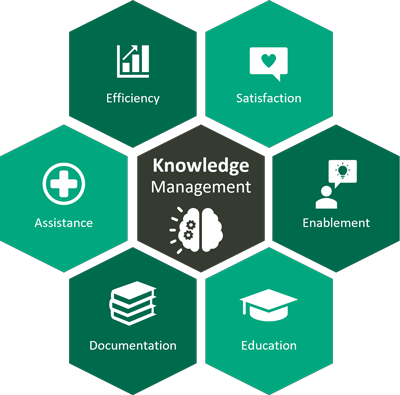Knowledge Management: Definition and Goal
According to ITIL, Knowledge Management is a process within IT Service Management that aims to strategically manage, share, and leverage knowledge within an organization. Systematic knowledge sharing can create a culture of learning and collaboration that fosters innovation and creative problem-solving.
The purpose of Knowledge Management is to ensure that knowledge is used efficiently to increase the effectiveness and efficiency of IT services, reduce incident and problem resolution times, and increase customer and user satisfaction. It also helps to avoid repetitive mistakes and spread best practices as well as experience throughout the company.
A well-organized Knowledge Management strategy can create a powerful knowledge base that improves the quality of IT services and helps create a learning and continuously improving IT organization.
What is a Knowledge Base?
The knowledge database is at the core of Knowledge Management and forms the heart of a well-organized knowledge structure. It acts as a central source to collect, structure and distribute knowledge, making a valuable contribution to the efficiency of business processes.
A knowledge base is a structured and organized collection of information, knowledge and resources that are digitally stored and easily accessible. This typically contains solutions to common problems, best practices, instructions, documentation, and other information relevant to employees and customers.
Knowledge Management process
Knowledge Management is a continuous process. By systematically capturing and using knowledge, an organization can improve its performance, develop innovative solutions, and respond successfully to change. The process can vary by organization and context, but here is a general description of the Knowledge Management process:
The role of AI in Knowledge Management
AI can improve various aspects of knowledge management. One of the most important areas is knowledge extraction and organization. AI can help to extract, structure and organize information from different sources, even if it is unstructured or in different formats. By using machine learning and natural language processing, these algorithms can understand texts, recognize patterns and categorize content.
Another important aspect is the provision of personalized recommendations. AI can analyze user behavior to understand individual preferences and needs. Based on these learnings, customized suggestions can then be offered for content or resources that are particularly relevant to the user.
Also worth mentioning is the important role of AI in the automation of processes. Routine tasks such as updating knowledge databases or answering frequently asked questions can be automated by AI-controlled systems.
One outstanding example is AI-supported ticket management. AI technologies make it possible to extract information from tickets and suggest solutions. This automation not only speeds up the entire support process, but also helps to ensure that knowledge is quickly accessible and used effectively.
Integration into other ITSM processes
Knowledge Management is closely linked to other ITIL processes such as Incident Management, Problem Management, Change Management and Service Level Management. This means that Knowledge Management provides relevant information for these processes and benefits from them.
Knowledge Management System
Knowledge Management Tools are software solutions to support the capture, organization, storage, search and sharing of knowledge within an organization. The central function of such tools is to provide a knowledge database in which knowledge articles, solutions and other information can be stored in a structured manner.
Invest in the right tools to help your team successfully address challenges and ensure long-term success. REALTECH offers an intelligent solution for this in the ITSM tool SmartITSM: our Knowledge Management System, which includes the following functions:
Conclusion: Knowledge Management
Knowledge Management is critical to ensuring an organization’s performance and innovation. With the right Knowledge Management Tools, you can not only systematically capture and share valuable knowledge, but also increase the efficiency of business processes. By accessing proven solutions, you can improve service quality and gain a knowledge advantage for sustainable success.
FAQs: Knowledge Management


